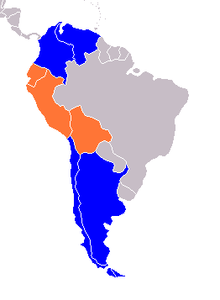Geography
The country of Bolivia has its name after the independence fighter Simon Bolivar which contributed to Bolivia’s break out of Spanish rule and the proclamation of its independence in 1825. Bolivia is located in the central part of the South American continent with neighboring countries such as Chile, Brazil, Paraguay and Peru. Bolivia consists of approximately 10.8 million people and it has approximately a size of 1.1 million square kilometers. In addition, Bolivia is a land-locked country. This is because Bolivia lost its coastline to Chile in the war of the Pacific in 1883 (CIA, 2016a).

Picture of South America in grey and Bolivia in green (CIA, 2016b).
La Paz is considered to be the seat of the government. However, Sucre is the constitutional capital of Bolivia. With an altitude of approximately 3600 meters, La Paz becomes the highest administrative capital in the world. This is because the Andes Mountains stretches through the western part of the South American continent. This makes Bolivia a country with huge differences in topography. For example, the western part of Bolivia, called the altiplano (high plateau), has an average altitude of 3600 meters above sea level. The eastern part of the country – the lowlands – forms a part of the Amazon rainforest and the Chaco grasslands southeast of the country. As a result, the climate changes from semiarid in the highlands to tropical in the lowlands. One should think that there are more inhabitants in the warmer climatic zones of Bolivia. However, almost half of the Bolivian population lives in the Altiplano in the cities of Oruro, Potosí and La Paz (Bolivian Information Forum, 2016a; Infoplease, 2016).

Map of Bolivia (CIA, 2016c).
Economy
The recent statistical data from the World Bank states that Bolivia is considered as one of the poorest countries in Latin America, where 50 percent of its population are living below the national poverty line (World Bank, 2011) and 7.7 percent live at 1.90 dollars a day (World Bank, 2013). Moreover, Bolivia has a gross domestic product (GDP) of 33.00 billion USD (World Bank, 2014), and a human development index (HDI) of 0.662 (Country Economy, 2014). In addition, Bolivia has also one of the highest income inequalities in Latin America (CIA, 2016a). Furthermore, Bolivia is also ranked close to the bottom among Latin American countries when it comes to health and development. The lack of clean water and a sufficient sanitary system, especially in the rural areas, is contributing to the health problems (WHO, 2015).
Even though Bolivia is considered as a poor country, it still has an abundance of natural resources like different sorts of minerals and hydrocarbons. Natural gas is most important to the Bolivian economy, since Bolivia gains a lot of income from the exports of the natural gas and it has become the main props of GDP growth. Moreover, Bolivia is the world’s third largest producer of coca. The income from the production of coca has been and still is significant for the Bolivian economy. However, Bolivia faces difficulties to be a part of international trade due to it is a land-locked country. According to Morales (2008), Bolivia needs to take fully part in patterns of international trade and attract flows of foreign capital to finance the investment needed for future growth (Morales, 2008, p.217).
Politics
As other countries in Latin America, Bolivia has an interesting history that includes many different economic and political shifts. The Bolivian politics since 1952 include an agrarian revolution, a military regime, a re-establishment of democracy to a left turn in politics (Bolivian Information Forum, 2016b). In recent years, the Bolivian economy has been characterized by a shift between first interventionist state-led development and then free-market neoliberalism (Morales, 2008, p.218-225).
Juan Evo Morales Ayma has been the President of Bolivia since he was elected with more than 50 percent of the votes in 2006 and in the reelection of 2009. Through different events such as Cochabamba’s water revolt in 2000, Morales showed a great leadership and gained more political power in Bolivia (Bolivian Information Forum, 2016b). When he was elected to the presidency of Bolivia in 2005, it showed a critical and historic moment of political and cultural transformation. “At the head of a party called the Movement Towards Socialism (Movimiento al Socialismo, MAS), Morales, coca farmer, peasant union leader, and Aymara Bolivian, became the first indigenous president of the country” (Fabricant and Gustafson, 2011, p.1). Some of Morales’ goals have been to nationalize the natural gas production and give the indigenous peoples the same rights as every citizen by changing the constitution of Bolivia (The Guardian, 2009). Since Morales second term of presidency from 2009, Bolivia has been defined as the Plurinational State of Bolivia (Estado Plurinacional de Bolivia) (Bolivia Information Forum, 2016b).
References:
Bolivian Information Forum. (2016a). Country Profile. Retrieved from: http://www.boliviainfoforum.org.uk/inside-page.asp?section=2&page=41
Bolivian Information Forum. (2016b). Politics. Retrieved from: http://www.boliviainfoforum.org.uk/inside-page.asp?section=3&page=29
CIA, Central Inteligence Agency. (2016a). The World Factbook: Bolivia. Retrieved from: https://www.cia.gov/library/publications/the-world-factbook/geos/bl.html
CIA. (2016b). The World Factbook: Bolivia. Map of South America. Retrieved from: https://www.cia.gov/library/publications/resources/the-world-factbook/geos/bl.html
CIA. (2016c). The World Factbook: Bolivia. Map of Bolivia. Retrieved from: https://www.cia.gov/library/publications/resources/the-world-factbook/geos/bl.html
Country Economy. (2014). Bolivia – Human Development Index – HDI. Retrieved from: http://countryeconomy.com/hdi/bolivia
Fabricant, N. and Gustafson, B. (2011). Remapping Bolivia: Resources, Territory, and Indigeneity in a Plurnational State. School for Advanced Research Global Indigenous Politics Series.
Infoplease. (2016). Bolivia. Retrieved from: https://www.infoplease.com/country/bolivia
Morales, J. A. (2008). Bolivia in a global setting. Economic Ties. In Crabtree, J. and Whitehead, L (Eds.), Unresolved Tensions. Bolivia. Past and Present. University of Pittsburgh Press, pp. 217-237.
WHO. (2015). Bolivia (Plurinational State of): WHO statistical profile. Retrieved from: http://www.who.int/gho/countries/bol.pdf?ua=1
World Bank. (2011). Poverty & Equity: Bolivia. People Living Below National Poverty Line. Retrieved from: http://povertydata.worldbank.org/poverty/country/BOL
World Bank. (2013). Poverty & Equity: Bolivia. People Living On Less Than $1.90 A Day. Retrieved from: http://povertydata.worldbank.org/poverty/country/BOL
World Bank. (2014). Data: Bolivia. GDP at market prices (current US$). Retrieved from: http://data.worldbank.org/country/bolivia





